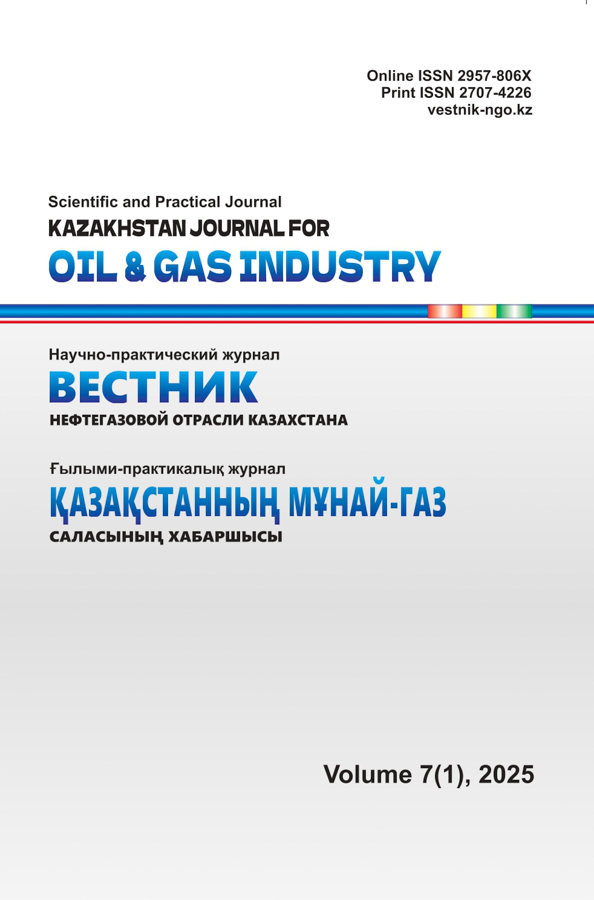Моделирование трещиноватости карбонатного резервуара на примере месторождения Восточный Урихтау
- Авторы: Кереев А.Б.1, Алдебек А.Е.1, Бондарук В.В.1, Марданов А.С.1
-
Учреждения:
- Атырауский филиал КМГ Инжиниринг
- Выпуск: Том 7, № 1 (2025)
- Страницы: 19-31
- Раздел: Геология
- URL: https://bakhtiniada.ru/2707-4226/article/view/293566
- DOI: https://doi.org/10.54859/kjogi108799
- ID: 293566
Цитировать
Полный текст
Аннотация
Обоснование. Моделирование трещиноватости карбонатных резервуаров играет ключевую роль в прогнозировании продуктивности скважин и оптимизации разработки месторождений. Восточный Урихтау расположен в восточной прибортовой зоне Прикаспийской впадины и характеризуется сложным тектоническим строением с развитой сетью разломов и трещин. Эти особенности существенно влияют на фильтрационно-ёмкостные свойства карбонатных коллекторов, что требует применения современных методов геологического моделирования. Создание детализированной модели трещиноватости позволяет более точно оценить структурные неоднородности и их влияние на миграцию и накопление углеводородов.
Цель. Исследование было направлено на построение трёхмерной модели трещиноватости карбонатного резервуара для выявления зон повышенной трещиноватости и их связи с продуктивностью скважин. Данная модель необходима для повышения точности прогнозирования фильтрационно-ёмкостных свойств коллекторов и разработки эффективных решений по дальнейшей эксплуатации месторождения.
Материалы и методы. В работе использованы современные методы геологического моделирования, включая интерпретацию данных FMI, анализ керна, сейсмические атрибуты и моделирование дискретной сети трещин (DFN). Исходные геолого-геофизические данные были обработаны в программном обеспечении Petrel с применением методов Ant Tracking и Distance to Object для определения направлений и интенсивности трещиноватости. Построенная трендовая модель легла в основу дискретного моделирования трещиноватости, что позволило количественно оценить степень трещиноватости и выделить наиболее перспективные зоны для дальнейшей разработки.
Результаты. Разработанная модель трещиноватости позволила детально определить зоны с повышенной трещиноватостью и установить их корреляцию с продуктивностью скважин. Было выявлено, что наиболее интенсивно трещиноватые зоны располагаются вблизи разломов, что подтверждается анализом дебитов флюидов. Использование методов Ant Tracking и DFN позволило минимизировать неопределенности в межскважинном пространстве и улучшить прогноз фильтрационно-емкостных свойств резервуара.
Заключение. Разработанная методика позволяет детализировать геологическое строение, повысить точность прогнозирования продуктивности скважин и оптимизировать планирование разработки. Полученные данные могут быть использованы при проектировании новых скважин и корректировке стратегии освоения месторождений с двойной пористостью и проницаемостью.
Полный текст
Открыть статью на сайте журналаОб авторах
Ануар Болатулы Кереев
Атырауский филиал КМГ Инжиниринг
Email: a.kereyev@kmge.kz
ORCID iD: 0009-0009-7494-0584
Казахстан, Атырау
Альмира Есенаманкызы Алдебек
Атырауский филиал КМГ Инжиниринг
Email: a.aldebek@kmge.kz
ORCID iD: 0009-0004-2233-4412
Казахстан, Атырау
Владислав Викторович Бондарук
Атырауский филиал КМГ Инжиниринг
Email: v.bondaruk@kmge.kz
ORCID iD: 0009-0008-6791-7290
Казахстан, Атырау
Алтынбек Сулейменулы Марданов
Атырауский филиал КМГ Инжиниринг
Автор, ответственный за переписку.
Email: a.mardanov@kmge.kz
ORCID iD: 0000-0002-8342-3046
Казахстан, Атырау
Список литературы
- Абилхасимов Х.Б. Особенности формирования природных резервуаров палеозойских отложений Прикаспийской впадины и оценка перспектив их нефтегазоносности. Москва : Издательский дом Академии Естествознания, 2016. 244 с.
- Ромм Е.С. Фильтрационные свойства трещиноватых горных пород. Москва : Недра, 1966. 271 c.
- Гудок Н.С., Богданович Н.Н., Мартынов В.Г. Определение физических свойств нефтеводосодержащих пород: учебное пособие для вузов. Москва : Недра, 2007.
- Булач М.Х., Белоновская Л.Г. Методические рекомендации по изучению и прогнозу коллекторов нефти и газа сложного типа. Ленинград : ВНИГРИ, 1989. 103 с.
- Багринцева К.И. Условия формирования и свойства карбонатных коллекторов нефти и газа. Москва : РГГУ, 1999. 285 с.
- Дальян И.Б. Особенности тектоники подсолевых комплексов восточной окраины Прикаспийской впадины в связи с нефтегазоносностью // Геология нефти и газа. 1996. №6. С. 8–17.
- Бражников О.Г. Перспективы нефтегазоносности Прикаспийской впадины с позиции тектоники плит: дисс. докт. геол.-мин. наук. Москва, 1993. Режим доступа: https://earthpapers.net/perspektivy-neftegazonosnosti-prikaspiyskoy-vpadiny-s-pozitsii-tektoniki-plit. Дата обращения: 10.12.2024.
- Козяев А.А., Щуковский Р.М., Закревский К.Е. Моделирование трещиноватости. Практикум по DFN в Petrel 2016–2019. Москва : МАИ, 2019. 94 с.
- Жолтаев Г.Ж., Кулумбетова Г.Е. Характеристика карбонатных и терригенных подсолевых отложений востока Прикаспийской впадины // Недра Поволжья и Прикаспия. 2019. Вып. 98. С. 65–77. doi: 10.24411/1997-8316-2019-19805.
- Ажгалиев Д.К. Уточнение модели строения подсолевой толщи восточной бортовой зоны Прикаспийской впадины // Геология нефти и газа. 2019. № 6. С. 31–40. doi: 10.31087/0016-7894-2019-6-31-40.
Дополнительные файлы






















